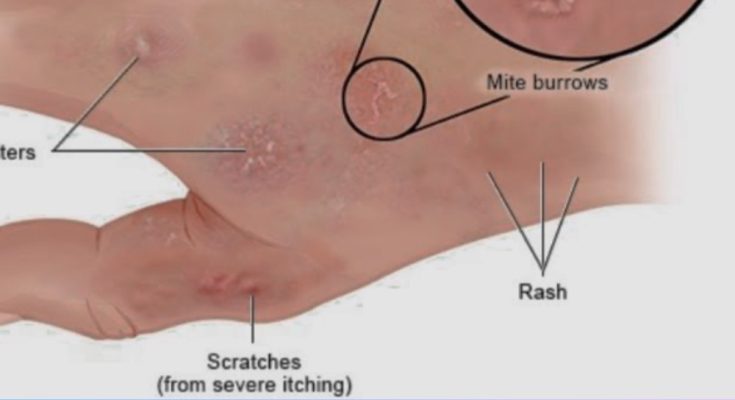Scabies is an intensely itchy skin condition caused by an infestation of tiny burrowing mites called Sarcoptes scabiei. It’s highly contagious and spreads primarily through prolonged skin-to-skin contact with an infected person. The itching and rash are due to the body’s allergic reaction to the mites, their eggs, and their waste products.
Symptoms of Scabies
The most characteristic symptoms of scabies include:
- Intense Itching (Pruritus): This is the hallmark symptom and is often severe, especially at night or after a hot bath or shower.
- Rash: The rash consists of tiny red bumps (papules) or blisters. It can appear anywhere on the body, but common areas include:
- Between the fingers and toes
- Wrists
- Elbows
- Armpits
- Waistline
- Genitals (penis, scrotum, nipples)
- Buttocks
- Soles of the feet (especially in infants and young children)
- Palms of the hands (especially in infants and young children)
- In infants and very young children, the rash can also appear on the head, face, and neck.
- Burrow Marks: These are tiny, raised, crooked or wavy lines (often grayish-white or skin-colored) on the skin surface, typically less than 1 cm long. They are caused by the female mites tunneling just beneath the skin to lay eggs. These burrows can be difficult to find as there may only be a small number of mites (around 10-15) in a typical infestation.
- Sores: Excessive scratching can break the skin, leading to open sores. These sores can become secondarily infected with bacteria, such as Staphylococcus aureus or Streptococcus, which may require antibiotic treatment.
Important Notes on Symptom Onset:
- If you’ve never had scabies before, symptoms can take 3 to 6 weeks to appear after initial exposure. During this time, you can still spread scabies to others, even without symptoms.
- If you’ve had scabies before, symptoms typically appear much faster, within 1 to 4 days of re-exposure.
Crusted Scabies (Norwegian Scabies): This is a rare but very severe form of scabies that can occur in individuals with weakened immune systems (e.g., elderly, those with HIV, or certain medical conditions). In crusted scabies, thousands to millions of mites are present, leading to thick, scaly, and crusted skin patches over large areas of the body. Unlike typical scabies, the itching may be mild or absent in crusted scabies. It is highly contagious.
Treatment
Scabies will not go away on its own and requires medical treatment. Over-the-counter products are generally not effective. Treatment involves prescribed medications that kill the mites and their eggs. It’s crucial that all household members and close contacts are treated at the same time, even if they don’t have symptoms, to prevent re-infestation.
Common treatments include:
- Permethrin Cream: This is the most common and generally safe first-line treatment for adults, pregnant or breastfeeding individuals, and children over 2 months old. It’s a chemical cream that is applied to the entire body (from the neck down, or to the entire head and body in young children and infants) and left on for a specified period (usually 8-14 hours) before being washed off. A second application is often recommended 7 days later.
- Sulfur Cream: Sulfur cream is another treatment option that can be applied overnight for several nights. It is considered safe for use during pregnancy and in infants under 2 months old
- Ivermectin (Oral Medication): This pill is prescribed for cases where topical lotions are not effective, or for individuals with crusted scabies or weakened immune systems. It is generally not recommended for pregnant or nursing individuals, or children weighing less than 33 pounds (15 kg).
Important Treatment Considerations:
- Itching may persist: Even after successful treatment, itching can continue for several weeks because the body is still reacting to dead mites and their byproducts. Your doctor may prescribe antihistamines or steroid creams to help manage the itching.
- Environmental decontamination:
- Wash all bedding, clothing, and towels used by the infested person and close contacts in hot water (at least 60°C or 122°F) and dry them in a hot dryer on the first day of treatment.
- Items that cannot be washed can be sealed in a plastic bag for at least 72 hours (or up to a week) to kill any remaining mites. Scabies mites generally do not survive more than 2-3 days away from human skin.
- Avoid direct skin-to-skin contact with others until treatment is completed.
- Notify people you’ve had direct skin-to-skin contact with in the previous two months so they can seek medical attention.
- Avoid insecticide sprays or fumigants: These are not effective for treating scabies in humans and can be harmful.
If you suspect you have scabies, it’s important to see a healthcare provider for an accurate diagnosis and appropriate treatment.

